

 |
|
|
| Vol. 8, No. 2 (March 2004) |
|
___Friedhelm |
Baukultur,
Stadtbaukultur, Planungskultur... :
Building Culture, Urban Design Culture, Planning Culture Dimensions |
|
The term
“Baukultur” signifies a highly ambiguous and contentious notion; as worn-out
and misused as “sustainability,” as ambiguous as “post-modernism,” as vague
as much of the discussion about “the European city”. If terms
such as these are to be more than hollow catch-phrases or fig leaves, they
demand a definition in the context in which they are used. The term
“Baukultur”
however,
appears to defy definition. What seems to be agreed is that “Baukultur” is a
reflection of the cultural state of society, of “Zeitgeist”, and that it is
desirable to make it flourish. What can be done, however, to help it on its way, is vigorously debated: People discuss whether “Baukultur” can be decreed, be it by order of professional bodies, democratic procedures, or authorities legitimised through proven artistic quality. Many are afraid that the notion of Baukultur may be understood in too narrow terms, i. e. in an elitist sense: aimed at the task of uplifting a banal, uneducated broader public in order to prepare the ground and improve the market situation so that an ailing design profession may be enabled to produce architectural masterpieces hallowed and sanctioned by an institutional stamp of approval, a stamp that might also improve the chances in the export sector. The title of the conference makes it clear that it makes sense to go beyond narrow definitions of the term in many respects. It would be difficult to try and develop a definitive, complete list of the dimensions of “Baukultur” between the aspects of power and participation, tradition and innovation, social content, economy and ecology, architecture and urban structure, process and result. For the purpose of providing key words for a discussion, here is a very tentative list anyway. It might be read as: “Baukultur” is about: Art, Aesthetics and Design, but also about: Power Participation, delegation of power, top-down versus bottom-up, Expert culture, elitism, pluralism Social dimension, ethics Social orientation / social responsibility; moral / ethical dimension Process Process-oriented vs. blueprint Structure and scale Focus on the architecture of individual buildings / orientation towards structure of whole city Building culture and public space Local / global dimensions Local / national / international / global , “world culture” Relationship to history, tradition, identity / “Modernity/Modernism” / “Post-modernism”… And it is about the question of quality. Again, it makes sense to look at ‘quality’ not simply in terms of the appearance of individual buildings but at various levels, at least in terms of the following three levels: processes (including cultural background, power structures) and their translation into the physical, spatial reality (buildings, spaces, structures …) and the use, utilisation of these, their consequences for people and cities, and finally their fate with the passage of time, which raises questions of sustainability. (How are space, buildings, structures used, abused, appreciated, understood, changed, destroyed, sustained…) The idea of this paper is then to pick a case study in which at least a number of the dimensions listed above become evident – some, in fact, in an extreme way. It is the case study of the Australian capital. The planning of Canberra reflects a number of these dimensions with a degree of clarity that may be hard to match: At the level of planning culture this involves the whole range of approaches from top-down professional expertism through neo-liberal anti-planning to the kind of groping (re-)discovery of urban development planning that planners in many countries are presently looking for. The major reason why it is so illuminating to look at Canberra from the angle of planning and building culture lies in the cultural function Canberra has had to fulfil since its conception in 1900: Its mission was not simply to be an administrative capital but to become the prestigious symbol of a young federation, in fact an “ideal city – the pride of time.” It was therefore endowed with planning powers and with resources that planners elsewhere can only dream of. These included political support from government, a high degree of planning control on the basis of public ownership of land, and for long periods of time, generous financial resources. In the absence of a political representation of the local population – it took as long as until 1989 that Canberra attained self-government – these exceptionally favourable circumstances enabled the planners to develop their visions of an ideal new town and capital. They did so with an equally exceptional degree of perfectionism. Canberra has of course not become the ideal city (that has yet to be developed) but at least a city that many find beautiful, a city that is effective and almost ideal for those it has been created for – mainly the up-and-coming public servant family – a city of parks and gardens, bungalows and automobiles, freeways and shopping centres, an optimised and subsidised suburbia, assembled around an artificial lake and an expansive government area. |
||||||
 Early modern  Modern  Catastrophic modern |
It has been
shaped by a series of planning and building cultures which belong to a
limited number of phases. These are cultural phases which can be found in
most Western countries. Using a loose,
typological approach, we might
very broadly call them “early modern” (preceding the 1920s), “modern”
up to the phase of the crisis of modernity in the second half of the 20th
century and merging into “post-modern” and into a phase we might term
“catastrophic late modern” (the icon being the demolition of
Pruitt Igoe) and then “neo-liberal post-modern”. What label to use for the present transitional phase is, of course, most difficult to decide, because we are still in it. Neo-liberalism with its seemingly naïve trust in the self-healing qualities of the market is not a thing of the past. But we can see new orientations towards a kind of planning which looks for a new type of urban development planning set within an altered framework of public and private actors within a civil society. Since this builds upon elements developed in modernism which have proved useful, we might call it “Modernism reloaded”. Simultaneously, there is evidence of "traditionalism reloaded", particularly in architecture and urban design (e. g. New Urbanism). The summary label might then be a new "Neue Unübersichtlichkeit." |
|||||
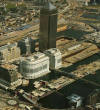 Neo-liberal post-modern |
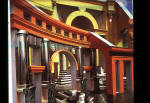 "Post-modern" |
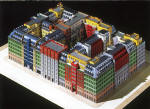 1987 IBA Post-modern |
 Careful urban renewa l |
|||
 Expert culture |
Each of
these phases is associated with different kinds of “Baukultur” and planning
culture – from the “expert culture” of ‘classic’ modernism to the more
process-oriented, more participatory planning culture of later phases (which
include integrated and careful urban renewal) as well as with specific
design conventions and iconographies. And thus the icons one may choose to
represent certain characteristics may vary between architectural master
pieces, personalities and their poses and something as abstract as a
flow-chart or a diagram. |
|||||
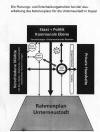 Process culture |
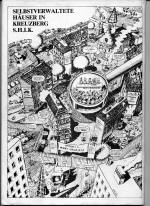 Bottom-up |
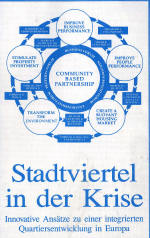 Integrated |
||||
|
Let us see now how these phases feature in the history of Canberra, and what
this may have to do with reflections about building and planning culture. Cities are reflections of the power structure, the material situation and the culture of the societies that build them. Focussing on the case study of Canberra we see that its very early history bears witness to the lively emancipist and reform ideas of the flourishing group of former colonial states which came together to found the new Commonwealth at the turn of the century. The plans for an impressive capital materialised under feelings of patriotism and economic optimism. They were shaped by the conflicting design forces of a society in a state of flux: a society that had yet to decide where it wanted to be going and whose structures were not yet too rigidified to enable it to do so. Thus the plans for the capital were affected by conflicting progressive, conservative and reactionary currents. Even though competitive thinking and shortsightedness influenced the locational decision at the regional level, and continued to hamper the development of the city up to World War Two, it was the progressive forces of the period of foundation that have left a lasting imprint on the capital. Early 20th century Australia was characterised by a social climate in which a strong will for democracy and egalitarianism led to the creation of legislation for women’s rights bills, manhood suffrage, minimum wage regulations and the beginnings of a trade union system. It was a period in which Australian legislation was ahead of that of many older nations. In an important instance, this political situation permitted Australia to learn from its bitter experience with a land-speculating “squattocracy” of grazers, and consequently to create a system of public ownership of land for its capital. |
||||||
|
|
Once all
city lands had been publicly acquired, a world-wide competition was opened
in 1911. In the following year, the first prize was awarded to the Chicago
architect Walter Burley Griffin, an associate of F. L. Wright. The plan
echoed Haussman’s Paris, Otto Wagner’s Vienna, the Chicago of the Burnham
plan and the City Beautiful as much as the principles of the Garden City. It
was a highly artistic masterpiece of great town planning expertise. Over the
years, it has found admiration for its harmony with the topography of the
site, its balance between classical and romantic elements as well as for its
amazingly advanced ideas on town planning. Features of the plan included
neighbourhood units and shopping centres connected by a tramway system
“borne at public expense”, ideas on functional and social mix, fine and
coarse grain, ideas on the public goods function of residential land and so
forth. It was the plan’s skilful use of space as a design element, (a feature that incorporated Japanese and Chinese ways of understanding space by treating natural features such as mountains as cornerstones of the design) that later made the urban designer Edmund Bacon call Canberra “A Statement of World Culture.” |
|||||
|
While these features are still apparent in today’s Canberra, the conception
of the city changed substantially after World War I, when the City Beautiful
ideal was replaced by a suburban garden city type of development. |
||||||
|
Images of persons
|
At the
background of these developments were drastic changes in planning culture
during the 1920s, which became amusingly visible in the poses those
responsible for planning chose to present for photographs: In the military culture after the war, Griffin,
the soft-spoken artist/architect, who had not learnt to use his elbows
in the rough pioneering community, had no chance of survival. His contract
was not renewed at the end of 1920. The task of developing the city was at
first taken over by the government departments involved, and from 1925 on by
a Commission endowed with highly centralised powers of planning, development
and administration, indeed powers such as Ernst May enjoyed them at the same
time in Frankfurt. In terms of finance, corporate planning powers and the
amount of construction work carried out, this meant the beginning of a
‘golden age’ for Canberra. Approaching its work like a large-scale
engineering project, the Commission succeeded in fulfilling its main task of
making Canberra ready for the opening of Parliament in 1927. The essential shift in the ideal concepts was that from the relatively high building density and the clearly urban atmosphere implied by the Griffin plan to the bungalow type of development which had already been described as characteristic for Australia in 1910 to the competitors for the Canberra plan. The skeleton of wide City Beautiful avenues was thus fleshed out with bungalows. Bungalows even replaced the two- to three-storey terrace houses sketched in Griffin’s central area perspective. And the lakeside promenade of cosmopolitan splendour with shops and cultural buildings envisaged in the original plan shrank to a traffic arterial blown up after World War II to highway proportions. |
|||||
|
|
The years
following the great depression were characterised by stagnation. The
Commission was abolished because of its ‘undemocratic behaviour’, and the
bad state of the Australian economy helped to put an end to a phase of
physically impressive construction achievements. It was only in the 1950s
that national economic growth and the financial centralisation of taxation
revenue brightened up the development prospects of the capital. But the
inter-war loss of orientation in terms of planning culture now required a
renewed political, intellectual and organisational effort. The coordinator
of this effort was the country’s leading political figure, Robert Menzies.
Australian Prime Minister from 1949 to 1966, Menzies had not only decided to
make Canberra the new symbol of Australian politics, but had chosen the city
as his personal favourite – much like Konrad Adenauer had chosen Bonn. |
|||||
|
|
Since the
inter-war years had only produced a half-finished town with the poor image
of “a good sheep station spoiled”, it seemed obvious that now, only rapid,
measurable progress and palpable design achievements could secure long-term
support from politicians and the public. Consequently Menzies created an
exceptionally powerful new organisation for planning and developing the
capital. He ensured that the new National Capital Development Commission (NCDC)
would have a large budget free from the constraints usually placed upon
government expenditure and that federal legislation and Parliamentary
support would continue to give it a high degree of planning control on the
basis of public ownership of land. These conditions helped the professional
planners to develop and implement their vision of an ideal new town and
capital; a vision, which, as it turned out, was largely a perfectionist
reflection of mainstream developments in British-American urban planning. It
was also characterised by a strong emphasis on visual aspects and an
increasingly technocratic approach to planning. Moreover, the NCDC clearly
acted as benevolent dictator until its New Town model was firmly on the
ground and in people’s heads, and through the 1960s, the absence of even
token gestures of public participation was coupled with a most restrictive policy of information release. Canberra
remained a city without self-government until late in 1988. |
|||||
|
While the
1960s were characterised by the importation of elements of the planning
culture developed in the British New Towns movement, it was the land use
transportation studies carried out by U.S. American consultants which shaped
the city’s growth from the 1970s on. American freeway suburbia provided the
frame within which the urban area was stretched into the form of a linear
city with ‘old Canberra’ at the centre. And this frame was fleshed out with
shopping centres, schools and roads graded in perfect hierarchies and
pre-determined values of houses and standardised building block sizes. |
||||||
|
The planning approach engendered confidence that Canberra’s urban problems
could be solved by systems planning and by approaching the task of urban
development as a mass production process. The planning approach was
consequently stripped down to its mass production essentials, and the main
components of the urban system standardised according to functional and
aesthetic criteria like any other product that is to be sold on the market.
In the new parts of Canberra, the “standardisation of the main components of
the urban system” soon became evident in carefully balanced shopping centres
and virtually identical neighbourhood modules that could be slotted into
pre-determined positions or exchanged when no longer desired. This highly
technocratic approach found its clearest expression in the NCDC’s own
description of their own urban development method as "an established,
repetitive, industrialized sequence". The Canberra of the 1970s and 80s
was both a planners' dream come true and the product of a nightmarish
sausage machine squirting out ready-made neighbourhood modules for a
standardized population. "We plan for a three-bedroom house, a General
Motors car and a motor mower", as one planner put it. Canberra's optimised and subsidised freeway-dependent suburbia assembled around a carefully balanced hierarchy of centres became a perfect manifestation of planners' ideal concepts in the Fordist age or the perfectionist Garden City Metropolis. |
||||||
|
|
An icon for
that phase is the functional and ground plan,
which gives an impression of the fact that the hierarchical planning
principles were applied with
almost ludicrous perfectionism.
The points of criticism of technocratic planning are obvious and have
been the object of criticism in many Western countries since the late 1960s.
We do not have to get into details here at this stage: Rigid functional segregation, the Blues in the New Towns and concrete agoraphobia in the town centres and a lack of public participation. In its Canberra form, the features of this kind of approach were particularly hard to sustain: extreme automobile dependence, water-dependence of abundant non-indigenous planting, and - most important in terms of the political economy - the feather-bedding of Canberra’s affluent population in a situation where land seemed to be available at zero value. Once the basis for luring anybody to Canberra at all, it became a privilege in boom-time Canberra that made the capital’s citizens reject self-government, one of the principles of planning in the mode of maturing modernism. |
|||||
|
|
On the
other hand it has to be
emphasized that the concept worked very much as
planned, managing to accommodate growth beyond 10% p.a. for many years
without significant hiccups in the development process. The concept worked
to the extent that the visionary artist’s rendering of Canberra drawn up in
the late 1960s, which depicts the city in the manner of an aerial photograph
as it might look in the beginning of the 21st century, could
almost be an aerial photograph of 2000. What is different is that, since the drawing was made, new government buildings have appeared in the central national area by the lake. The most noteworthy among these is the new ‘post-modern’ Parliament House opened in 1988, one of the few distinguished works of architecture and “Baukultur” in the narrower sense in Canberra. The concept worked – at least until “the real world” hit, until the market developed too much of its own dynamic and public funds were seriously diminishing, until the carefully balanced pyramid of shopping centres started to crumble, until the population began to age, and the relation of schools and population was no longer what it was when the young families moved into their new suburbs. This city was, as so many things in life, janus-faced: beautiful, efficient and also benign in environmental terms (until the bush fires in 2002/03 hit), just perfect for the population it had been designed for (the public servant family with 2.1 kids and preferably two cars), yet in certain ways a strangely monstrous exemplar of metropolitan mass-production and optimisation strategies; an impressive design achievement, yet mediocre in architectural terms. While this is slowly changing by the addition of exceptional buildings such as the Museum of Australia, the contrast between Canberra and cities like Brasilia with its stunning pieces of architecture is still as great as ever. The explanation of this phenomenon could be tied to one item in the NCDC’s financial statements. Between 68 and 75 % of its household expenditure each year was allocated to ‘normal basic community requirements’ – i. e. roads, services, schools, community facilities and the like. It is obvious that often, not much has remained for splendid pieces of architecture and monumental government buildings. In Brasilia, this proportion must be vastly different. This makes for an exciting Brazilian capital and contributes to the decidedly unexciting appearance of Canberra. The difference is also that between a consumer-oriented, meritocratic welfare society and a Third World country with a vast population in fact exploited by a thin upper crust. From the beginning Canberra had three childhood problems: One associated with administration, one with urban economics, and one with self-government. The restricted occupational structure in the purely administrative capital limited the city’s development potential. And the urban economic problems associated with Canberra’s young age resulted in part from the decades of foundation, when the desire to get people to the ‘capital village’ in the first place had resulted in a practice of spoon-feeding its growing, affluent population with cheap electricity, free water and in the early days even a free hedge-clipping service, and when the ubiquitous availability of publicly owned land seemed to suggest that unlimited land was available at zero cost. It seemed obvious that none of this would continue once self-government would be granted. This is why all the public votes for self-government ended with a “no”, i. e. a declaration of dependence, a state for which the Australian economy as a whole had to pay. |
|||||
|
With the
rise of Thatcherism, the cure for these interrelated problems was seen in
neo-liberal solutions. The steps taken during the 1970s and 1980s were
designed as if to prove to the world, yet again, that neo-liberalism is
about depleting public resources, enriching the wealthy and fishing off
surplus capital from a broader population. First, conservative Prime Minister Gorton virtually abolished the leasehold system – at least in its public revenue-producing aspects. Nobody had anyway really understood how it worked. But those who had just been paying annual fees for their lease, now suddenly found themselves owning the land. Good for them. Too bad for the newcomers to Canberra, who had to pay the full capital price for their home building lot. |
||||||
|
Unimproved land values
|
27,000 leases of land valued at $ 230 million (including income-producing
commercial leases on land worth $ 40 million) were given away and converted
into virtual freehold land. Following this depletion of public resources,
land prices rose automatically. But a new Office of Assets Management
established by a neo-liberal government saw its task in strengthening this
trend by restricting the supply of land. By the turn of the century, its
head declared that it could “take pride in its success of raising land
prices to Sydney levels”. By 2004, Canberra was reported to have left Sydney
suburban price levels behind – a triumph that has a bitter taste not only
for home buyers in Canberra but also for those who remember that Canberra’s
founding fathers had once created the system of public ownership of land to
ensure equitable land prices for a broader population. Next, the capital was declared to be basically complete. (Strange enough this meant that conservative Prime Minister John Howard could shift his residence to Sydney, which in any case was where the big deals were made.) And if the capital was finished, it seemed obvious that it did not require spatial planning on a substantial scale any more. Running a city was seen as a task of land management. Planners, architects and engineers could be replaced by economists and managers. Privatisation, small government, staff reduction, de-professionalisation, and radical outsourcing were the key words for the following chapter in Canberra’s history. In 1988, Canberra was finally granted self-government – a step that appeared long overdue in a democratic society. The particular administrative arrangement, however, has to be seen in the context of the economic and political climate of those years, which was characterised by the above key words. The planning authority that had guided the city’s growth for decades, the NCDC, was abolished. It was replaced by a municipal land management authority with reduced planning functions (PALM = Planning and Land Management) and by an authority specifically responsible for National Area functions (NCPA = National Capital Planning Authority). But the neo-liberal aversion to planning meant that there were to many Ps in the recipe. Consequently, just as the leasehold system had been emasculated, so did the NCPA have its P cut off, downgrading it to an NCA. In the case of PALM, the recipe had been to “severely prune the urban-economic and social-planning functions”. As a consequence, architects and planners, planning knowledge and corporate memory were scattered and lost. Under the pressure of neo-liberal politics, the scope of action of the remaining planning staff became increasingly limited. The strategies of small government and outsourcing were applied in a critical and eventually catastrophic manner. Thus for example, in order to maximise development opportunities and to reduce capital costs of urban development, suburban projects were packaged and handed over to builders who were given the opportunity to develop substantial estates in a deregulated environment: Suburban street patterns and site plans were no longer designed by planners but by builders, whose legitimate single interest consisted in maximising their profit; building control was thinned down in a manner that became instantly visible in a shocking drop of standards. Architects were a species virtually unseen in the process. But the developers picked up the planning lingo quickly: If the regulations could be twisted to squeeze more houses on a package of land, this was proclaimed to happen in the name of sustainability, even if all rules of site planning and traditional ecological design were violated: The Australian house lost its veranda and even its eaves, which kept the midday sun from heating it and allowed the low-standing winter sun to warm it. PALM designed an excellent sustainability rating index with consequences for sales prices of houses. But when you look out over the roofscape of the new suburbs there is virtually no house that is not dominated by huge air conditioning plant. It is as if the last residual bits of local Australian building culture had been forgotten. In the late 1990s, the loss of memory and professionalism cumulated in a characteristically catastrophic constellation. It had been decided that the old Canberra Hospital built in the 1930s was to make way for a new national institution, the Museum of Australia. While the museum as such was highly welcomed in Canberra, the decision for its location on the hospital site met with some opposition, not least because many people’s lives were in some way connected with the traditional hospital, many having given birth or having been born at this hospital. In order to overplay this unease, it was decided to stage the demolition of the hospital as a big party and festival event. In contrast to the traditional demolition process of exploding buildings such as seen most spectacularly in the Pruitt Igoe complex, a relatively new technology was to be applied, which would result in the implosion of the building. From a relatively short distance, the citizens were to be able to watch the spectacle of a building collapsing upon itself. They were to gather around the lake with their picnic baskets and on their sailing boats, and enjoy the good weather and the fireworks of the implosion. Unfortunately, the demolition job was commissioned in the phase of deregulated neo-liberalism. It went to a company which was new to the trade and which was offering to do it cheaper than the established ones. In the general environment of de-professionalisation, where architects had been replaced by builders, and planners by economists and project developers, the company’s credentials were nor adequately checked. And in the state of a complete disinterest in corporate memory, the building deeds, which would have shown how the hospital had been constructed in the early 1940s were difficult to trace, because the archives and library at the city’s planning department had been dissolved. They were a cost factor that could easily be eliminated if the essential task of planning was defined as attracting and channelling investment capital as efficiently as possible. The practice of outsourcing professional staff had left no experts to be asked for advice. Had this been different, the construction drawings would have revealed the hospital to be made of very thick concrete walls with very strong steel armour. (A knowledge of building history would have been helpful too, because back in those days, it was not unusual to employ steel armoured concrete, almost as in a bunker, for the construction of public buildings.) But as it was, on that 13 July 1997 the contractor discovered the enormous solidity of the building too late. Virtually in a last-minute effort to avoid the ridiculous effect of some noise and no action, he multiplied the amount of explosives. |
|||||
|
The result was catastrophic. Instead of imploding and properly collapsing,
the building exploded. The debris scattered
all across the lake, injuring people, bombarding boats in the lake and
beheading a girl standing in a line of spectators by the lake shore. There followed, of course, an enquiry looking for someone to be held responsible beyond the demolition contractor. But there were also voices recognising that the blame beyond individual culprits and scapegoats who happened to be acting in the hospital incident was with a political context, a regulatory system and a planning culture that had sunk to a catastrophic low. |
||||||
|
Late in
2001, a change in government at the local level brought in the Labor Party.
Urban planning had been one of the great themes of the election campaign,
and a decisive factor for the victory of Labor. Within its first year of
office, the new planning minister formulated a program that entailed many of
the ideal concepts which tend to form part of a new agenda for planning
discussed internationally over more than the last decade. |
||||||
|
|
Social inclusion, increased sustainability through higher usage of public
transport, and innovative ways to engage the different actors in new
patterns of public-private partnership arrangements were announced to be
pursued by three integrated plans: A social plan, an economic plan and a
spatial plan, which were to be developed in a consultative process between
government and the community. These are to include a range of partial plans
e.g. for the introduction of a tramway system, for new social neighbourhood
planning concepts etc. As yet, it is too early to say much about the quality
of the plans and the processes behind them.
|
|||||
| feedback | ||||||